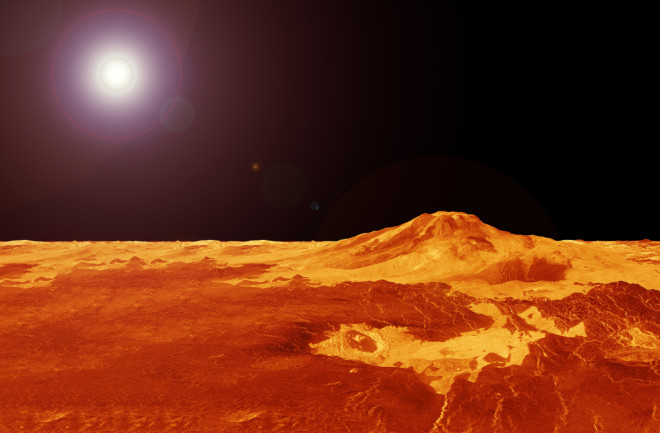Earth and Venus can sometimes be seen as twins. The planets, second and third from our Sun, are close to the same in size (7,521 mile diameter for Venus, 7,918 mile diameter for Earth), nearly identical in density (5.24 vs. 5.5 grams per cubic centimetre) and both are constructed from layers of rock and metal consisting of a thin outer crust, thick mantle and metallic core.
Not Much of a Twin
Yet, those mostly superficial similarities disguise the fact that in many ways, the planets couldn't be more different. It takes 365 Earth days for our planet to travel around the Sun and 1 Earth day (24 hours) to rotate on its axis. Venus? 243 Earth days to travel around the Sun but it takes 225 Earth days to rotation on its axis. That means one Venusian year is ~1.08 Venusian days long ... and the Sun rises in the west. Yes, Venus spins in the opposite direction of Earth.
If that's not weird enough, the planet's surface conditions are opposites. On Earth, our average surface temperature is a relatively-pleasant 59°F (15C) with an atmosphere mostly made of nitrogen (78%), oxygen (20%), water (4%) with about 0.4% carbon dioxide (enough to make a health greenhouse to keep us warm ... maybe too warm).
Transport yourself to the surface of Venus and you'll be roasting (literally) at 900°F (475C). Your lungs would fill with an atmosphere of 96.5% carbon dioxide mixed with nitrogen and sulfur dioxide ... and a pressure seventy-five times what you feel on Earth thanks to the thickness of the Venusian atmosphere.
A Young Surface
What might be most remarkably about Venus is just how prevalent the evidence of volcanism is seen on the planet. The surface looks geologically-young, maybe on average only a few hundred million years old. This means that lava likely erases the evidence of any impacts that occurred in Venus' past and remodels the surface on a regular basis.
Earth is a highly volcanically-active planet thanks to plate tectonics, the process where the Earth's crustal plates interact. We have ~25,000 miles of mid-ocean ridges where new lava can erupt to push plates around. There are ~1,500 potentially active volcanoes on Earth as well, with likely ten times more volcanic edifices that might have been active in the past ten million years.
A Volcanic Census
A new study in the Journal of Geophysical Research Planets by Becca Hahn and Paul Byrne at Washington University of St. Louis took a census of volcanic features larger than ~3 miles (5 kilometers) on Venus and found an astonishing 85,000 of them! They seem to exist as a mix of large volcanoes (over 60 miles / 100 kilometers across) and smaller volcanoes (3-12 miles / 5-20 kilometers), with many of the smaller ones clustering in clusters.
Using data collected by NASA's Magellan radar during the 1990s, Hahn and Byrne identified as many volcanic features as possible to complete this count. Of these volcanoes, 118 were larger than 60 miles (100 kilometers) across -- something like Mauna Loa or Yellowstone in size. These big volcanoes are found near the Venusian equator called the "Beta-Alta-Themis" (or BAT) region where the crust is thicker (10.3 miles / 16.5 kilometers) than on other parts of the planet.
However, the vast majority were much smaller shield volcanoes that are closer to what we find on Earth in the Auckland Volcanic Field of New Zealand or the Belknap Crater region in Central Oregon. Many exist in volcanic fields with as many as 800 volcanoes but average about 100 in each field.
Now, the ultimate source of all the magma needed to feed these volcanoes is still speculative for Venus. Few missions have penetrated the clouds of the planet for a close look at the surface. Likely the lava that feeds these volcanoes are basalt like we find in Hawai'i today. This might mean that magma comes from plumes of hot material in the Venusian mantle. However, Hahn and Byrne suggests some of the larger volcanoes in thicker crust are fed from shallow reservoirs in the crust being supplied from magma deep in the mantle.
In all cases, a closer look at Venus is well deserved. We have yet to confirm if any active eruptions have occurred on the planet since we've been able to observe its atmosphere from Earth. Without constant, close monitoring, we likely would miss the transient plumes related to volcanism. This might be coming in the next decade, when NASA and ESA are supposed to send three new missions to Venus including DAVINCI, EnVision and VERITAS. Maybe then we can see if Venus could be as active today as the abundance of volcanoes on its surface suggest.


